Multiplication is incredibly simple with Tables 2 through 20, which also improves our problem-solving skills. Learning the multiplication tables from 2 to 20 by heart is still a very effective strategy, even in the age of readily available calculators. Therefore, the tables from 2 to 20 are highly helpful in reducing stress when performing arithmetic computations involving multiplication, fractions, ratios, and division. The multiplication tables from 2 to 20 on this page can be downloaded and printed with ease, even though we all know that writing multiplication tables down is always the best method to learn them. These must to be positioned so they are constantly easily seen. This facilitates quicker memorization of them.
Let’s use 2 to 20 table charts, which may be downloaded and printed as needed, to learn multiplication tables from 2 to 20. Let’s also study a variety of hints and techniques to help us perform simple and rapid computations.
Tables Chart 2 to 20
The chart with 2 to 20 tables shown below facilitates quicker calculations, which in turn helps to lessen math-related stress.
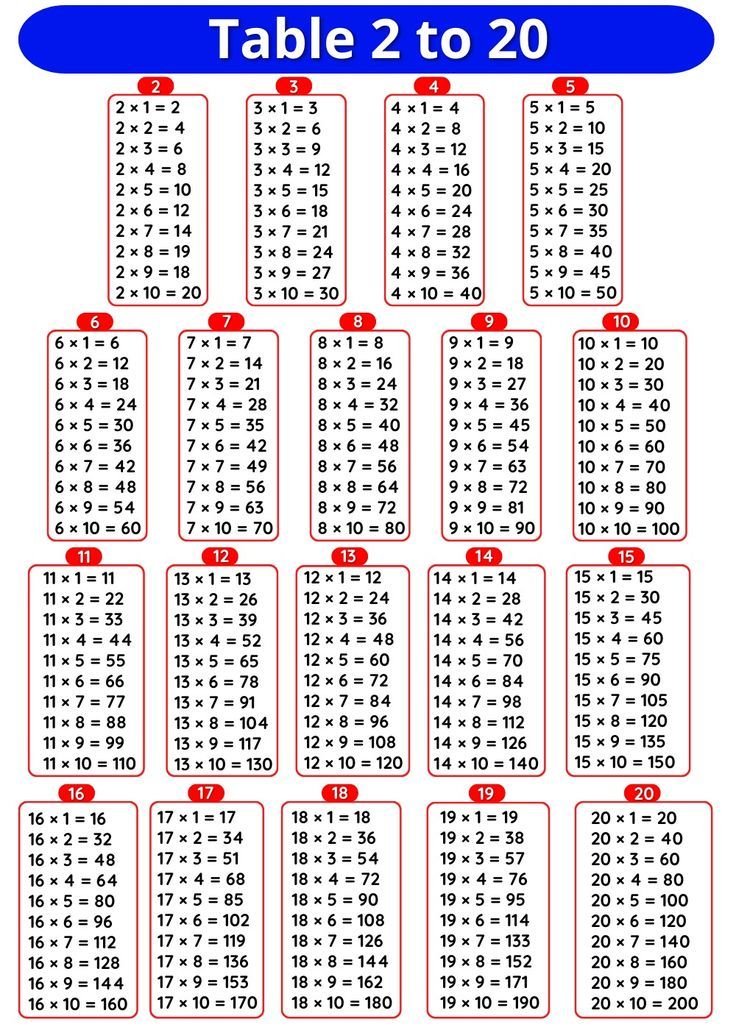
Tables from 2 to 20
Learning the multiplication tables from 2 to 20 by heart not only boosts confidence but also keeps knowledge ready. Math problems can be completed far more quickly by students who have a stronger grasp of multiplication tables. When addressing difficult issues, a solid foundation on tables from 2 to 20 can save a significant amount of computational time. Therefore, for quick fundamental estimations, it is advised to study all of the math tables from 2 to 20 listed below.
Tables from 2 to 5
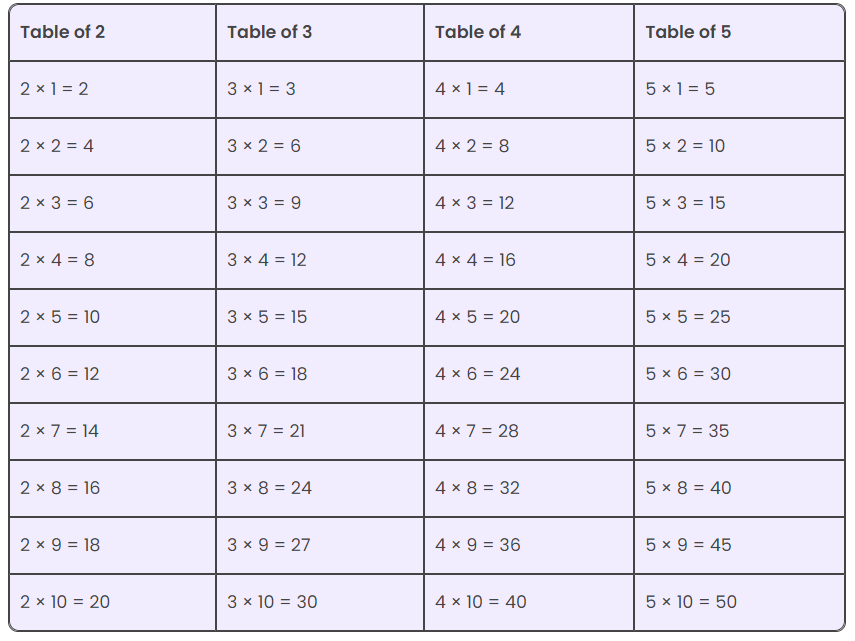
Tables 6 to 10
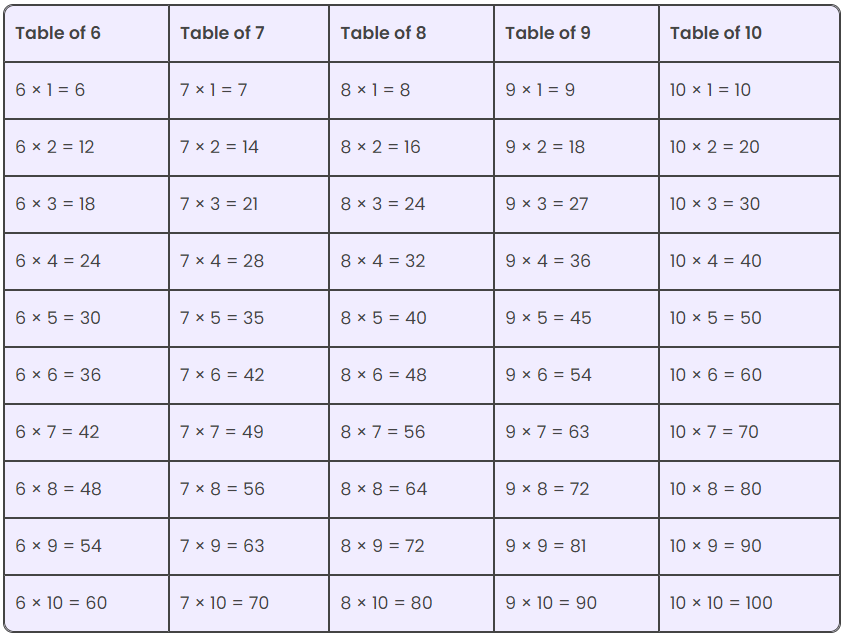
Tables 11 to 15
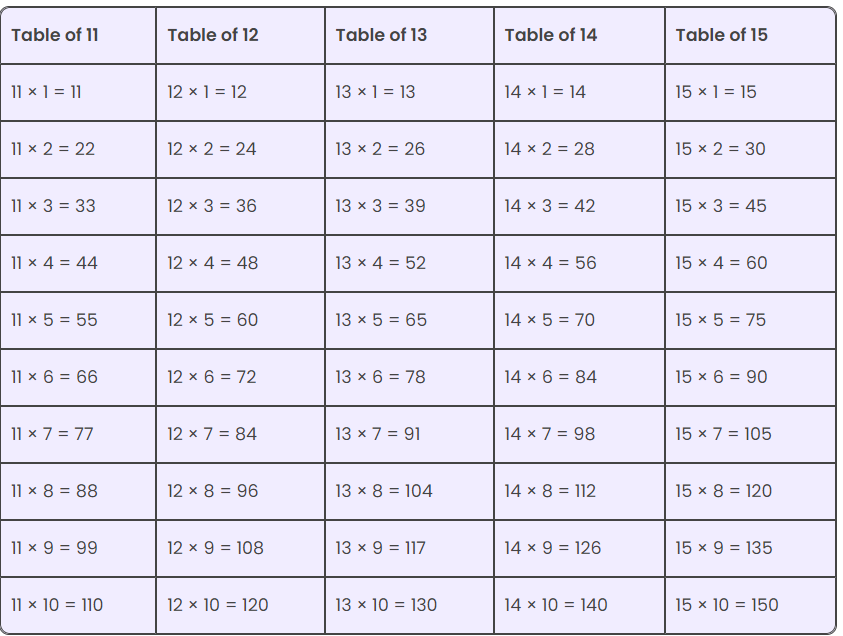
Table 16 to 20
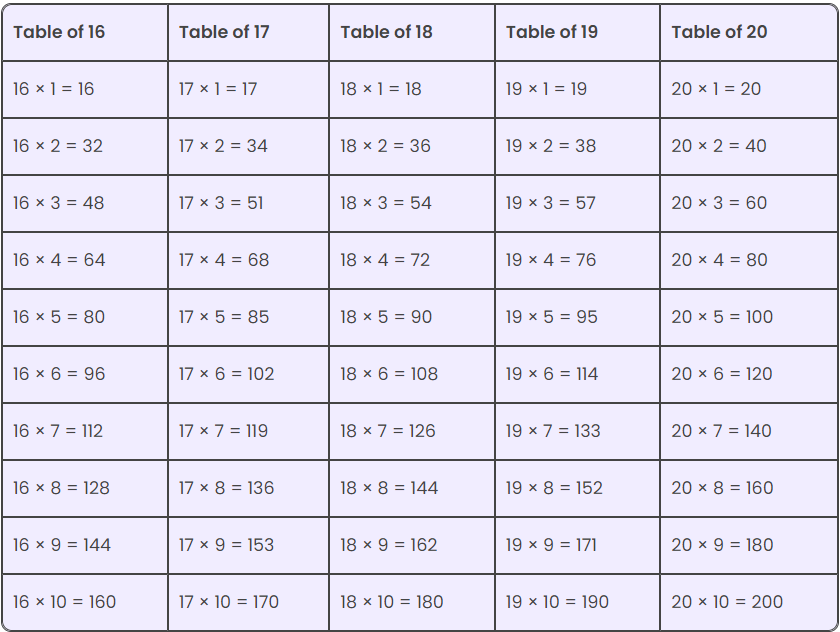
Maths Tables 2 to 20 Tricks
We may simply learn the multiplication tables from 2 to 20 by using the following hints and techniques.
- In order to learn the multiplication tables more quickly, consider writing them out at least twice while speaking along with yourself.
- Put the handwritten tables or the printout on a wall adjacent to the study table so that you can always see them clearly. This facilitates speedy revision, memorization, and time savings.
- Every multiplication table has a consistent format. If it is a table of two, then adding two to each multiple to produce the subsequent multiple will yield the multiplication table of two. This indicates that every one of its multiples has a difference of 2. 2, 4, 6, 8, 10, 12, and so on are some examples. This rule holds true for all tables. For instance, if the table is of six, the multiplication table of six can be found by multiplying each multiple by six to get the subsequent multiple.
- The final multiple in the table of five is either 0 or 5.
- An even integer multiplied by six equals the same even number as the product’s final digit. As an illustration, 6 × 4 = 24, 6 × 6 = 36, and 6 × 8 = 48.
- There is a pattern in the multiplication table of 19 that makes writing it simple. Write the first ten odd integers in a sequence, starting at the top and working your way down, in the product column. 1, 3, 5, 7, 9, and so on are a few examples. Now begin writing the numbers 0 through 9 in the units location starting from the other side, that is, from bottom to top. For instance, 1, 2, 3, 4, and so forth. The products appear in order when these numbers are added together.
- The multiplication tables from 2 to 20 contain whole numbers for each and every number.
Tables 2 to 20 Examples
FAQs on Tables 2 to 20
How to Read Tables from 2 to 20?
Multiplication tables from 2 to any numbers can be recited in the following manner. Let us take an example of the table of 2.
- two ones are two (2 × 1 = 2)
- two twos are four (2 × 2 = 4)
- two threes are six (2 × 3 = 6)
- two fours are eight (2 × 4 = 8)
- two fives are ten (2 × 5 = 10)
- two sixes are twelve (2 × 6 = 12) and so on.
What is the Fastest Way to Memorize the Multiplication Tables from 2 to 5?
The following tips will help you memorize multiplication tables from 2 to 5 in the fastest way possible.
- The multiplication table of 2 can be memorized by adding 2 to each multiple to get the next multiple. For example, we know that 2 × 1 = 2, so for the next row of 2 × 2, we can add 2 to the previous product which makes it 2 + 2 = 4. Similarly, for the next row of 2 × 3, we can add 2 to the previous product which makes it 2 + 4 = 6, so 2 × 3 = 6. This means there is a difference of 2 in each of its multiples.
- The multiplication table of 3 can be learned by adding 3 to each multiple to get the next multiple. This means there is a difference of 3 in each of its multiples. For example, 3, 6, 9, 12, 15, and so on.
- The multiplication table of 4 can be obtained by adding 4 to each multiple to get the next multiple. This means there is a difference of 4 in each of its multiples. For example, 4, 8, 12,16, 20, and so on.
- Every number in the table of 5 either ends in 0 or 5. For example, 10 or 15. This means there is a difference of 5 in each of its multiples. In other words, we can add 5 to each multiple to get the next multiple. For example, 5, 10, 15, 20, 25, and so on.
How are 2 to 20 Tables Used in Everyday Life?
The multiplication tables from 2 to 20 are used in everyday life. A few examples are given below.
- They help in the calculation of mathematical parameters like area and volumes, etc.
- 2 to 20 tables are used by vendors, shopkeepers, etc to determine the amount to be paid by their customers.
What are the Benefits of Learning Tables from 2 to 20?
The benefits of learning multiplication tables from 2 to 20 are:
- They help in working out math problems easily.
- Multiplication tables 2 to 20 boost the arithmetic capabilities of a student.
How to Learn Multiplication Table 2 to 20 Easily?
The multiplication tables from 2 to 20 can be learned easily by using a few tips given below.
- All the multiplication tables follow a pattern. If it is the table of 7, then it can be obtained by adding 7 to each multiple to get the next multiple. This means there is a difference of 7 in each of its multiples. For example, 7, 14, 21, 28, 35, 42, and so on. This rule applies to all tables, for example, if it is the multiplication table of 6, then it can be obtained by adding 6 to each multiple to get the next multiple.
- Write the multiplication tables at least twice to learn them.
- Place the printout or the handwritten tables somewhere where they are always visible clearly, perhaps on the wall next to the table where you study. This helps in saving time and memorizing them.
How to Learn and Write Tables from 2 to 20?
The multiplication tables from 2 to 20 can be written in a simple pattern as shown above in this page in detail. Here are a few tips that could be helpful in learning them..
- Place the tables right in front of your study table so that it is always visible to you and you can revise them whenever you look up at them.
- Try and write the tables in the format as shown above and practice writing it at least twice while saying each row aloud. Saying it aloud helps in memorizing it faster.
- Apart from this, there is a common rule that applies to all the multiplication tables and which helps in writing them easily. All the multiplication tables follow a pattern. If it is the table of 8, then it can be obtained by adding 8 to each multiple to get the next multiple. This means there is a difference of 8 in each of its multiples. For example, 8 × 1 = 8, 8 × 2 = 16, 8 × 3 = 24, 8 × 4 = 32 and so on. This rule applies to all tables, for example, if it is the multiplication table of 12, then it can be obtained by adding 12 to each multiple to get the next multiple.

